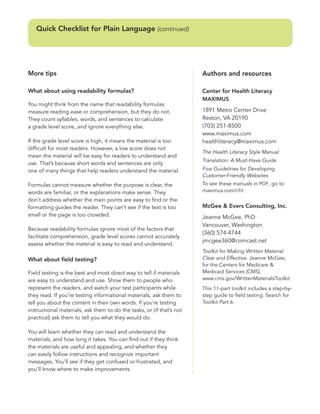Jeanne McGee and the Center for Health Literacy - Quick checklist for plain language
- 1. Quick Checklist for Plain Language Center for Health Literacy | MAXIMUS and McGee & Evers Consulting, Inc. This checklist will help you see if print and web materials are written in plain language and formatted in ways that help readers find and understand key messages. Check each item below that is present in the material. The more items with checks, the more likely it will be that readers can understand and use the material. Reader focus Design and formatting The title and introduction tell what the The material has similar style and structure material is about, whom it is for, and how to throughout, with consistent use of fonts, use it. italics, bold print, color, numbers, and bullets. The tone is direct, friendly, and positive, using The material looks inviting and easy to read, personal pronouns such as Ī░youĪ▒ and Ī░we.Ī▒ with an uncluttered layout, plenty of white space, and dark colored type on a light The content is limited to what readers need background. to know, and anticipates their questions and concerns. The fonts are clean in their design and easy to read (not fancy or unusual). Organization The text size is large enough for easy reading The material begins with the most important and each line has about 10 to 15 words. message. Italics and bold print are used sparingly. The content is arranged in an order that Images are clear and uncluttered, related makes sense to readers. to the content, and culturally appropriate for Informative headings signal whatĪ»s coming the readers. and make it easy for readers to skim. Tips for checking the language Writing Take a careful look at the vocabulary. Identify The writing is mostly in the active voice. words you think readers would be unlikely to use in their everyday speech. Whenever The words are common and familiar to the possible, replace these words with others that intended readers. would be easier and more familiar. Acronyms, abbreviations, technical terms, Read it aloud or have someone read it and legal terms are used only if readers need to you. You will hear if the tone is too formal, to know them. If used, they are explained. the wording is awkward, the sentences Paragraphs are one topic and brief, with are too long, or the paragraphs too dense. simple and straightforward sentences. Key terms are used consistently. Turn over for more tips and resources ?? Instructions are brief, step-by-step, and placed right where readers need them. The writing is cohesive ©C making connections among ideas to help readers understand and absorb new information.
- 2. Quick Checklist for Plain Language (continued) More tips Authors and resources What about using readability formulas? Center for Health Literacy MAXIMUS You might think from the name that readability formulas measure reading ease or comprehension, but they do not. 1891 Metro Center Drive They count syllables, words, and sentences to calculate Reston, VA 20190 a grade level score, and ignore everything else. (703) 251-8500 www.maximus.com If the grade level score is high, it means the material is too healthliteracy@maximus.com difficult for most readers. However, a low score does not The Health Literacy Style Manual mean the material will be easy for readers to understand and Translation: A Must-Have Guide use. ThatĪ»s because short words and sentences are only one of many things that help readers understand the material. Five Guidelines for Developing Customer-Friendly Websites Formulas cannot measure whether the purpose is clear, the To see these manuals in PDF, go to words are familiar, or the explanations make sense. They maximus.com/chl. donĪ»t address whether the main points are easy to find or the formatting guides the reader. They canĪ»t see if the text is too McGee & Evers Consulting, Inc. small or the page is too crowded. Jeanne McGee, PhD Vancouver, Washington Because readability formulas ignore most of the factors that (360) 574-4744 facilitate comprehension, grade level scores cannot accurately jmcgee360@comcast.net assess whether the material is easy to read and understand. Toolkit for Making Written Material What about field testing? Clear and Effective. Jeanne McGee, for the Centers for Medicare & Field testing is the best and most direct way to tell if materials Medicaid Services (CMS). are easy to understand and use. Show them to people who www.cms.gov/WrittenMaterialsToolkit represent the readers, and watch your test participants while This 11-part toolkit includes a step-by- they read. If youĪ»re testing informational materials, ask them to step guide to field testing. Search for tell you about the content in their own words. If youĪ»re testing Toolkit Part 6. instructional materials, ask them to do the tasks, or (if thatĪ»s not practical) ask them to tell you what they would do. You will learn whether they can read and understand the materials, and how long it takes. You can find out if they think the materials are useful and appealing, and whether they can easily follow instructions and recognize important messages. YouĪ»ll see if they get confused or frustrated, and youĪ»ll know where to make improvements.


